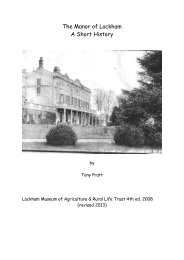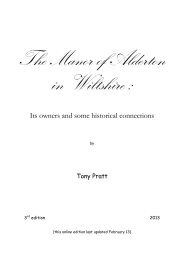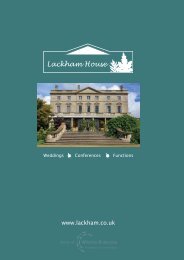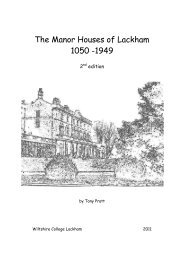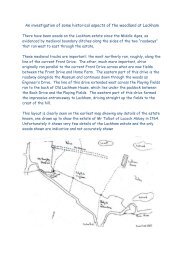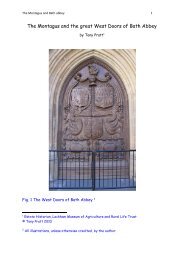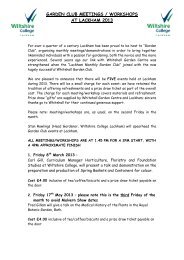History of Agricultural Education in Wiltshire - Lackham Countryside ...
History of Agricultural Education in Wiltshire - Lackham Countryside ...
History of Agricultural Education in Wiltshire - Lackham Countryside ...
Create successful ePaper yourself
Turn your PDF publications into a flip-book with our unique Google optimized e-Paper software.
CHAPTER III<br />
LACKHAM HOUSE AND ESTATE 1000-1970<br />
It is <strong>in</strong>terest<strong>in</strong>g to f<strong>in</strong>d that a huge <strong>Agricultural</strong> Estate stretch<strong>in</strong>g from<br />
Chippenham to Lacock and a Manor existed at <strong>Lackham</strong> several hundred years<br />
before Lacock Abbey, founded by Ela, the Countess <strong>of</strong> Salisbury, <strong>in</strong> 1232.<br />
A f<strong>in</strong>e old Manor House is mentioned <strong>in</strong> Wilts "Notes and Queries‖ March 1899<br />
dat<strong>in</strong>g at least from medieval times, for many ages, the residence sucessively <strong>of</strong><br />
the Bluet, Baynard and Montagu families. Unfortunately James Montagu V had<br />
the ancient and historic house demolished between 1791—96 and had built <strong>in</strong> its<br />
place a Georgian house with a debased classical front, described by Britton <strong>in</strong><br />
"Beauties <strong>of</strong> Wilts" Volume III, page 246, 1825 "as a pla<strong>in</strong> edifice situated <strong>in</strong> a<br />
rich fertile vale near the banks <strong>of</strong> the river Avon". S<strong>in</strong>ce then, many alterations<br />
have been made and it is now the Headquarters <strong>of</strong> the <strong>Lackham</strong> College <strong>of</strong><br />
Agriculture,<br />
The destruction <strong>of</strong> the ancient Manor House was a sad blow to the County <strong>of</strong><br />
<strong>Wiltshire</strong>: one <strong>of</strong> its gems gone forever.<br />
The earliest sketch <strong>of</strong> the Manor appears <strong>in</strong> D<strong>in</strong>gley's "<strong>History</strong> from Marble"<br />
compiled <strong>in</strong> the reign <strong>of</strong> Charles II, 1867-8. The sketch was taken at the close<br />
<strong>of</strong> the reign <strong>of</strong> Charles II <strong>in</strong> 1684. It represents the house as an irregular<br />
structure, evidently <strong>of</strong> different dates (Norman <strong>in</strong> places), enclosed <strong>in</strong> a large<br />
courtyard and completely embosomed <strong>in</strong> woods. The River Avon close by formed<br />
the ancient boundary <strong>of</strong> the Royal forest <strong>of</strong> Pewsham, <strong>in</strong> which the Lords <strong>of</strong><br />
<strong>Lackham</strong> enjoyed the right <strong>of</strong> hunt<strong>in</strong>g by grant from Edward III, which grant<br />
cont<strong>in</strong>ued <strong>in</strong> force until the disafforestation <strong>of</strong> Pewsham <strong>in</strong> the reign <strong>of</strong> James<br />
I.<br />
A second sketch illustrates draw<strong>in</strong>gs by Grimm <strong>of</strong> the central portion <strong>of</strong> the<br />
build<strong>in</strong>g, taken August 1790. The porch forms a pr<strong>in</strong>cipal feature. A shield on<br />
the gable is apparently carved with the Arms <strong>of</strong> Bluet and Baynard and another<br />
shield at the base <strong>of</strong> the project<strong>in</strong>g w<strong>in</strong>dow over the entrance bears Baynard<br />
quarter<strong>in</strong>g Bluet with two unicorns as supporters.<br />
The Great Hall was to the left on enter<strong>in</strong>g the porch.<br />
Accord<strong>in</strong>g to Aubrey, writ<strong>in</strong>g <strong>in</strong> 1670, the great Gothic halls were kept for d<strong>in</strong><strong>in</strong>g<br />
and enterta<strong>in</strong><strong>in</strong>g.




